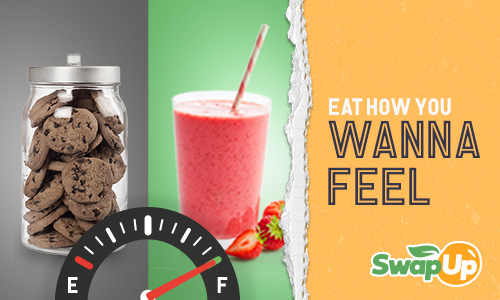
Oklahoma has the eighth highest youth obesity rate in the country, with an estimated 150,000 children who are classified as overweight or obese. Obesity prevalence is significantly higher among those living in rural counties, where Indigenous groups are the largest population of color. Though most teens want to be and feel healthy, our research has found that they often don’t consider how their food choices impact their health. Instead, they gravitate toward foods their peers eat, taste good, or that are cheap and convenient.
Studies have found that natural foods are linked to higher rates of happiness, and kids who eat more fruits and vegetables are more likely to do better in school. Meanwhile processed foods are linked to higher rates of anxiety, depression, and stress that can affect focus and memory and are shown to be associated with poorer attention and visual learning. However, teens are more likely to appreciate the importance of food choices if they are tied to concrete, immediate effects on their lives. Gaining weight in the future, developing diabetes one day, or just feeling generally better is not motivating or specific enough. With this information, we sought to deliver specific, realistic, and memorable nutrition advice that teens can easily incorporate into their daily lives. Our specific goal is to convince teens that swapping a side or snack for a healthier option is not as challenging as changing your entire diet, and it’s worth it to help you feel and perform your best every day.
In order to reach teens who typically have a short-sighted outlook on their eating habits, we sought to associate the pros of healthy snack swaps (strength, focus, happiness, satisfied hunger) and cons of unhealthy snacks (weak, tired, moody, hungry/bloated) to their lifestyles and everyday activities. We wanted to show them how what they were eating was affecting things like athletic performance, alertness, or energy for class. Specific focus was given to rural teenagers, who faced a higher obesity prevalence and needed specific, relatable messaging delivered. Swap Up’s first step was a baseline survey with 400+ Oklahoma teenagers to gain insights into their nutrition-related knowledge, habits, attitudes, and beliefs. We gained valuable information like how often they drank water, their intent to change their poor eating behaviors, and barriers to eating fruits and vegetables. From there we developed several creative concepts designed to motivate teens to swap out unhealthy foods for produce and sugar sweetened beverages (SSBs) for water that were message tested with Oklahoma teenagers and refined according to their feedback.
We created multiple message packages employing our SAVI approach (with goals that are specific, attainable, viable, and impactful) containing a 30-second flagship video along with a library of creative social assets to increase knowledge about the immediate impact of food on the body and mind. As Oklahoma has many agricultural and farming communities, we specifically created videos to resonate with teens in rural areas and used diverse talent to ensure proper representation among racial demographics. The ads were activated on multiple channels, including:
Radio
Television
Cable
OTT Media
Snapchat
YouTube
During the eligible timeframe, two message packages (each with one rural and one urban video) were completed. The packages, titled Watermercial and Crave Control, ran from August through October, 2022, and January through March, 2023, respectively.
Additionally, on March 22, 2023, we deployed a Swap Up Day for schools and community organizations across the state with a like-minded goal of teaching Oklahoma teenagers about healthy food options. We ideated a concept that would appeal to both rural and urban teenagers: a Swap Up Cafe that encourages teens to “Eat How You Wanna Feel.” At the event, teens could order food based on a feeling, rather than picking an item they want to eat. For instance, if a teen placed a “Happy” order, the host then served them a healthy food that has been scientifically proven to increase one’s mood. We also created a 5 page microsite featuring a digital experience that teaches how food fuels one’s mind and body.
We created an ‘event-in-a-box’ to send to hosts with everything they would need for a successful day. In addition to a $100 Visa Card to purchase healthy food, the following physical items were designed, printed, and given in each host box:
A 20+ page event guide
A branded table cover
Tabletop menu signs
Branded magnets to giveaway
An educational Swap Up card game
A QR stand linking to the website
Branded water bottles to giveaway
Promotional signage
Watermercial message package:
22,078,476 impressions (approximately 7.7m to rural audiences and 14.3m to urban audiences) across digital and social media channels
184K social media post engagements
Crave Control message package:
26,481,605 impressions (approximately 9.2m to rural audiences and 17.2m to urban audiences) across digital and social media channels
243K social media post engagements
Day of Action:
71 host sites, including schools, community centers, and various coalitions
100 boxes delivered with enough materials to reach 70,000+ Oklahoma teenagers
Our online tracker with 221 Oklahoma teen participants found:
High levels of campaign awareness across urban (70%) and rural (66%) populations, with 53% of participants saying they have engaged with the campaign on social media.
Evidence that active engagement with campaign content may be particularly important for shifting attitudes, beliefs, intentions, and behaviors.
Teens who engaged with the campaign were significantly more likely to associate drinking more water and fewer SSBs with better sports performance, clearer thinking and improved mood, compared to those who did not engage with the campaign.
Teens who engaged with the campaign were more likely to report positive attitudes and intentions toward eating more produce, drinking more water and drinking fewer SSBs, compared to those who did not engage with the campaign.
Swap Up aware teens were 15% more likely to have consumed fruit and 21% more likely to have consumed vegetables in the past 7 days, compared to those who had not been exposed to the campaign.








